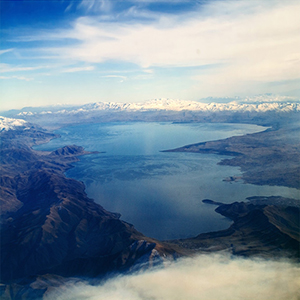Simulating thermal dynamics of the largest lake in the Caucasus region: The mountain Lake Sevan

Accepted: 29 September 2021
HTML: 25
All claims expressed in this article are solely those of the authors and do not necessarily represent those of their affiliated organizations, or those of the publisher, the editors and the reviewers. Any product that may be evaluated in this article or claim that may be made by its manufacturer is not guaranteed or endorsed by the publisher.
Authors
Lake Sevan is the largest freshwater body in the Caucasus region, situated at an altitude of 1,900 m asl. While it is a major water resource in the whole region, Lake Sevan has received little attention in international limnological literature. Although recent studies pointed to algal blooms and negative impacts of climate change and eutrophication, the physical controls on thermal dynamics have not been characterized and model-based assessments of climate change impacts are lacking. We compiled a decade of historical data for meteorological conditions and temperature dynamics in Lake Sevan and used a one-dimensional hydrodynamic model (GLM 3.1) in order to study thermal structure, the stratification phenology and their meteorological drivers in this large mountain lake. We then evaluated the representativeness of meteorological data products covering almost 4 decades (EWEMBI-dataset: 1979-2016) for driving the model and found that these data are well suited to restore long term thermal dynamics in Lake Sevan. This established model setting allowed us to identify major changes in Lake Sevan’s stratification in response to changing meteorological conditions as expected from ongoing climate change. Our results point to a changing mixing type from dimictic to monomictic as Lake Sevan will experience prolonged summer stratification periods and more stable stratification. These projected changes in stratification must be included in long-term management perspectives as they will intensify water quality deteriorations like surface algal blooms or deep water anoxia.
Edited by
Bardukh Gabrielyan, Scientific Center of Zoology and Hydroecology, Division of Natural Sciences, Yerevan, ArmeniaCollege of Water Conservancy, Shenyang Agricultural University, Shenyang, China
Hydrometeorology and Monitoring Center SNCO of the Ministry of Environment of the Republic of Armenia, Yerevan, Armenia
How to Cite

This work is licensed under a Creative Commons Attribution-NonCommercial 4.0 International License.
Similar Articles
- Anita Galir Balkić, The importance of environmental differences in the structuring of rotifer functional diversity , Journal of Limnology: Vol. 78 No. 3 (2019)
- Stefanie VON FUMETTI, Peter NAGEL, A first approach to a faunistic crenon typology based on functional feeding groups , Journal of Limnology: Vol. 70 No. s1 (2011): Springs: neglected key habitats for biodiversity conservation
- Nadja MØBJERG, Aslak JØRGENSEN, Jette EIBYE-JACOBSEN, Kenneth AGERLIN HALBERG, Dennis PERSSON, Reinhardt MØBJERG KRISTENSEN, New records on cyclomorphosis in the marine eutardigrade Halobiotus crispae (Eutardigrada: Hypsibiidae) , Journal of Limnology: Vol. 66 No. s1 (2007): 10th International Symposium on Tardigrada
- Daniel Nyqvist, Matiss Zagars, Olle Calles, Claudio Comoglio, Behavior of trap-and-transported Atlantic salmon spawners of hatchery origin in the Daugava River system (Latvia) , Journal of Limnology: Vol. 78 No. 2 (2019)
- Rosario MOSELLO, Aldo MARCHETTO, Maria C. BRIZZIO, Michela ROGORA, Gabriele A. TARTARI, Results from the Italian participation in the International Co-operative Programme on Assessment and Monitoring of Acidification of Rivers and Lakes (ICP Waters) , Journal of Limnology: Vol. 59 No. 1 (2000)
- Michal Grabowski, Kamil Hupało, Aneta Bylak, Krzysztof Kukuła, Joanna Grabowska, Double origin of the racer goby (Babka gymnotrachelus) in Poland revealed with mitochondrial marker. Possible implications for the species alien/native status , Journal of Limnology: Vol. 75 No. 1 (2016)
- Malcolm G. Butler, Shane D. Braegelman, Pre-emergence growth and development in the arctic midge Trichotanypus alaskensis Brundin , Journal of Limnology: Vol. 77 No. s1 (2018): Recent advances in the study of Chironomidae: An overview
- Ana Maria GERALDES, Maria-José BOAVIDA, Do distinct water chemistry, reservoir age and disturbance make any difference on phosphatase activity? , Journal of Limnology: Vol. 62 No. 2 (2003)
- Cristiana CALLIERI, John G. STOCKNER, Freshwater autotrophic picoplankton: a review , Journal of Limnology: Vol. 61 No. 1 (2002)
You may also start an advanced similarity search for this article.
-
Muhammed Shikhani, Johannes Feldbauer, Robert Ladwig, Daniel Mercado‐Bettín, Tadhg N. Moore, Artur Gevorgyan, Amalya Misakyan, Chenxi Mi, Martin Schultze, Bertram Boehrer, Tom Shatwell, Klemens Barfus, Karsten RinkeWater Resources Research : 2024
-
Gor Gevorgyan, Wolf Von Tuempling, Gayane Shahnazaryan, Kurt Friese, Martin SchultzeJournal of Limnology : 2023
-
Tallent Dadi, Wolf Von Tümpling, Chenxi Mi, Martin Schultze, Kurt FrieseJournal of Limnology : 2023
-
Svein Vagle, Eddy CarmackFrontiers in Earth Science : 2023
-
Gayane Shahnazaryan, Martin Schultze, Karsten Rinke, Bardukh GabrielyanJournal of Limnology : 2023
-
Torsten Haberzettl, Marie-Luise Adolph, Taron Grigoryan, Hayk Hovakimyan, Thomas Kasper, Norbert Nowaczyk, Christian Zeeden, Lilit SahakyanQuaternary Science Reviews : 2024
-
Armine Hayrapetyan, Gor Gevorgyan , Martin Schultze, Muhammed Shikhani, Termine Khachikyan, Aleksandr Krylov, Karsten RinkeJournal of Limnology : 2023

 https://doi.org/10.4081/jlimnol.2021.2024
https://doi.org/10.4081/jlimnol.2021.2024





